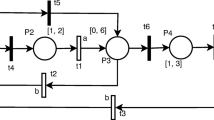Abstract
This article deals with the problem of fault prognosis in stochastic discrete event systems. For that purpose, partially observed stochastic Petri nets are considered to model the system with its sensors. The model represents both healthy and faulty behaviors of the system. Our goal is, based on a timed measurement trajectory issued from the sensors, to compute the probability that a fault will occur in a future time interval. To this end, a procedure based on an incremental algorithm is proposed to compute the set of consistent behaviors of the system. Based on the measurement dates, the probabilities of the consistent trajectories are evaluated and a state estimation is obtained as a consequence. From the set of possible current states and their probabilities, a method to evaluate the probability of future faults is developed using a probabilistic model. An example is presented to illustrate the results.





Similar content being viewed by others
References
Amari SV, Misra RB (1997) Closed-form expressions for distribution of sum of exponential random variables. IEEE Trans Reliab 46(4):519–522
Ammour R, Leclercq E, Sanlaville E, Lefebvre D (2016) Faults prognosis using partially observed stochastic Petri nets. In: 13th international workshop on discrete event systems (WODES), Xi’an, China, pp 472–477
Bobbio A, Puliafito A, Telek M, Trivedi K (1998) Recent developments in Stochastic Petri Nets. J Circ Syst Comput 8(1):119–158
Cassandras C, Lafortune S (2008) Introduction to discrete event systems, 2nd edn. Springer, New York
Cassez F, Grastien A (2013) Predictability of event occurrences in timed systems. In: Formal modeling and analysis of timed systems, pp 62–76
Diaz M (2013) Petri nets: fundamental models, verification and applications. Wiley
Chen J, Kumar R (2015) Stochastic failure prognosability of discrete event systems. IEEE Trans Auto Control 60(6):1570–1581
Finkel A (1993) The minimal coverability graph for Petri nets. In: Advances in Petri Nets, pp 210–243
Genc S, Lafortune S (2009) Predictability of event occurrences in partially-observed discrete-event systems. Automatica 45(2):301–311
Haddad S, Moreaux P (2009) Stochastic Petri nets, Chapter 9. In: Petri Nets: fundamental models and applications. Wiley
Jéron T, Marchand H, Genc S, Lafortune S (2008) Predictability of sequence patterns in discrete event systems. In: Proceedings of the 17th IFAC World congress. Seoul, Korea, pp 537–543
Khoumsi A, Chakib H (2012) Conjunctive and disjunctive architectures for decentralized prognosis of failures in discrete-event systems. IEEE Trans Autom Sci Eng 9(2):412–417
Kumar R, Takai S (2010) Decentralized prognosis of failures in discrete event systems. IEEE Trans Autom Control 55(1):48–59
Lefebvre D (2014) Fault diagnosis and prognosis with partially observed stochastic Petri nets. Proc IMechE Part O: J Risk Reliab 228(4):382–396
Marsan MA, Balbo CG, Donatelli S, Franceschinis G (1994) Modelling with generalized stochastic Petri Nets. Wiley series in parallel computing. Wiley
Miner AS, Ciardo G (1999) Efficient reachability set generation and storage using decision diagrams. In: International conference on application and theory of Petri Nets. Springer, Berlin Heidelberg , pp 6–25
Molloy M (1982) Performance analysis using stochastic Petri nets. IEEE Trans Comput 100(9):913–917
Nouioua F, Dague P, Ye L (2014) Probabilistic analysis of predictability in discrete event systems. In: 25th international workshop on principles of diagnosis (DX’14), Paris, France
Prosser H, Kam M, Kwatny HG (1998) Online supervisor synthesis for partially observed discrete-event systems. IEEE Trans Autom Control 43(11):1630–1634
Ross SM (2010) Introduction to probability models, 10th edn. Academic Press, Elsevier
Ru Y, Hadjiscotis CN (2009) Fault diagnosis in discrete event systems modeled by partially observed Petri nets. Discre Event Dyn Syst 19(4):551–575
Sampath M et al (1995) Diagnosability of discrete-event systems. IEEE Trans Autmatic Control 40(9):1555–1575
Takai S (2015) Robust prognosability for a set of partially observed discrete event systems. Automatica 51:123–130
Yin X, Li Z (2016) Decentralized fault prognosis of discrete event systems with guaranteed performance bound. Automatica 69:375–379
Acknowledgments
This project (TERA-MRT MADNESS 2016) has been funded with the support from the European Union with the European Regional Development Fund (ERDF) and from the Regional Council of Normandie.
Author information
Authors and Affiliations
Corresponding author
Additional information
This article belongs to the Topical Collection: Special Issue on Diagnosis, Opacity and Supervisory Control of Discrete Event Systems
Guest Editors: Christos G. Cassandras and Alessandro Giua
Appendix
Appendix
The subroutine Sil_events is given by the following recursive algorithm that computes the set SilTrajSet from a given trajectory (σ, M). This set contains, in addition to the considered trajectory (σ, M), all the possible continuations that do not provide any new label nor a change in the measured marking. This algorithm is similar to the unobservable reach operation proposed in Cassandras and Lafortune (2008) for partially observed DES.

Consist_event is given by the following algorithm. It computes, from a given trajectory (σ, M) that leads to the marking M ′ and measurement ejobs(Mjobs), the set of trajectories of type (σT, M), such that the event T provides the new label ejobs and leads to the new measured marking (Mjobs). The idea of this algorithm is similar to the one used for supervisory theory in Prosser et al. (1998).

Rights and permissions
About this article
Cite this article
Ammour, R., Leclercq, E., Sanlaville, E. et al. Faults prognosis using partially observed stochastic Petri-nets: an incremental approach. Discrete Event Dyn Syst 28, 247–267 (2018). https://doi.org/10.1007/s10626-017-0252-y
Received:
Accepted:
Published:
Issue Date:
DOI: https://doi.org/10.1007/s10626-017-0252-y





